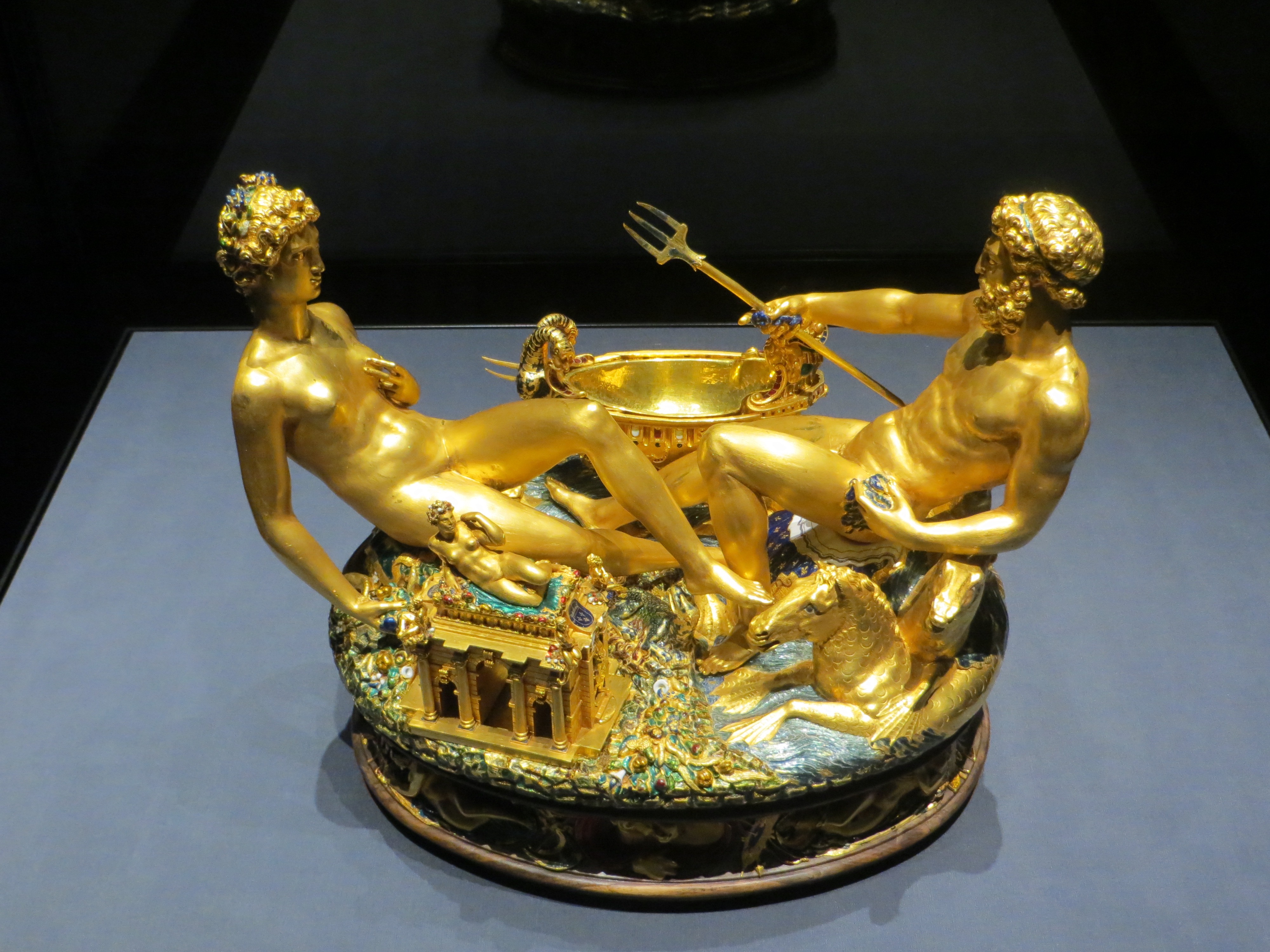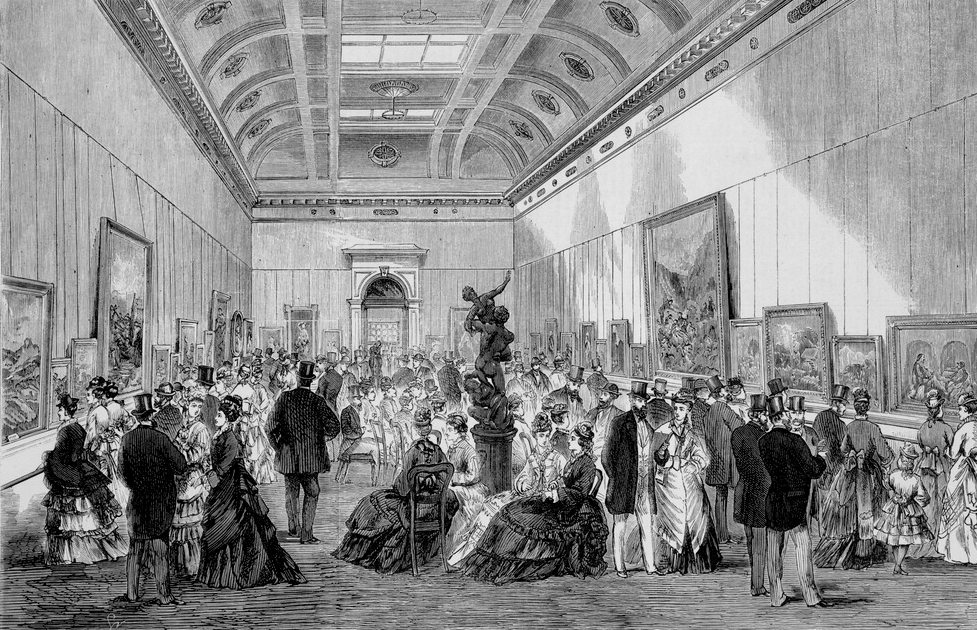|
Anne Smith (silversmith)
Anne Smith was an English silversmith working in partnership with Nathaniel Appleton. Unusually, Smith does not appear to have been the widow of a silversmith when she registered her mark on 26 July 1771; her marital status at the time is given instead as "unknown". She lived in Aldersgate Street and was classified as a smallworker. Her partnership with Appleton appears in the Parliamentary Report list of 1773. The couple specialized in the making of saltcellars and small cream jugs. A George III cream jug of 1773 and a set of four George III saltcellars of 1782 by the partners are owned by the National Museum of Women in the Arts, while a collection of saltcellars is owned by the National Gallery of Victoria The National Gallery of Victoria, popularly known as the NGV, is an art museum in Melbourne, Victoria (Australia), Victoria, Australia. Founded in 1861, it is Australia's oldest and list of most visited art museums in the world, most visited ar .... Numerous other pieces ... [...More Info...] [...Related Items...] OR: [Wikipedia] [Google] [Baidu] |
Aldersgate Street
Aldersgate is a Ward of the City of London, named after one of the northern gates in the London Wall which once enclosed the City. The Ward of Aldersgate is traditionally divided into Aldersgate Within and Aldersgate Without, the suffix denoting whether the part was within the line of the wall or outside it. The ancient ward boundaries were redrawn in 2013; the names are preserved but their location only loosely approximates to their historic extent. The gate also gave its name to Aldersgate Street, which runs north from the former gate towards Clerkenwell. The street was wholly part of Aldersgate Without ward until a short section further north was renamed and so added to it. The gate The Wall was first built around the year 200, but Aldersgate was not one of the original Roman gates, being added later in the Roman period. The name ''Aldersgate'' is first recorded around 1000 in the form ''Ealdredesgate'', i.e. "gate associated with a man named Ealdrād"; the gate proba ... [...More Info...] [...Related Items...] OR: [Wikipedia] [Google] [Baidu] |
Smallworker
A largeworker was a form of silversmith in England from the 17th to the early 20th centuries who made items of a larger size such as dishes or candlesticks. When craftsmen registered their mark they would classify themselves as "goldworker", "smallworker", or "largeworker" according to their skill and specialism. The Silver Society. Retrieved 8 December 2017. References External links Metalworking terminology Silversmithing {{England-stub ...[...More Info...] [...Related Items...] OR: [Wikipedia] [Google] [Baidu] |
Saltcellar
A salt cellar (also called a salt, salt-box and a salt pig) is an article of tableware for holding and dispensing salt. In British English, the term is normally used for what in North American English are called salt shakers. Salt cellars can be either lidded or open, and are found in a wide range of sizes, from large shared vessels to small individual dishes. Styles range from simple to ornate or whimsical, using materials including glass and ceramic, metals, ivory and wood, and plastic. Use of salt cellars is documented as early as classical Rome. They continued to be used through the first half of the 20th century; however, usage began to decline with the introduction of free-flowing salt in 1911, and at last they have been almost entirely replaced by salt shakers. Salt cellars were an early collectible as pieces of silver, pewter, glass, etc. Soon after their role at the table was replaced by the shaker, salt cellars became a popular collectible in their own right. Etym ... [...More Info...] [...Related Items...] OR: [Wikipedia] [Google] [Baidu] |
Philippa Glanville
Philippa Jane Glanville, OBE, FSA (born 16 August 1943), formerly chief curator of the metal, silver and jewellery department of the Victoria and Albert Museum, is an English art historian who is an authority on silver and the history of dining. Early life The daughter of the Rev. Wilfred Henry Fox-Robinson and Jane Mary Home, she was educated at Talbot Heath School, Bournemouth, before going up to Girton College, Cambridge, where she read History, and taking a degree in Archives Administration at University College, London. While at Cambridge she took part in the archaeological excavations at Winchester conducted by Martin Biddle, later Professor of Medieval Archaeology at Oxford. Career After graduating, she joined the London Museum (later the Museum of London) as curator in the Tudor and Stuart department, from 1966 to 1972, and as head of department from 1972 to 1980. Her interest in the history of food was stimulated in 1968 by curating a London Museum exhibition on Tud ... [...More Info...] [...Related Items...] OR: [Wikipedia] [Google] [Baidu] |
National Museum Of Women In The Arts
The National Museum of Women in the Arts (NMWA), located in Washington, D.C., is "the first museum in the world solely dedicated" to championing women through the arts. NMWA was incorporated in 1981 by Wallace and Wilhelmina Holladay. Since opening in 1987, the museum has acquired a collection of more than 5,500 works by more than 1,000 artists, ranging from the 16th century to today. The collection includes works by Frida Kahlo, Mary Cassatt, Alma Woodsey Thomas, Élisabeth Louise Vigée-LeBrun, and Amy Sherald. NMWA also holds the only painting by Frida Kahlo in Washington, D.C. The museum occupies an old Masonic Temple, a building listed on the U.S. National Register of Historic Places. History The museum was founded to reform traditional histories of art. It is dedicated to discovering and making known women artists who have been overlooked, erased, or unacknowledged, and assuring the place of women in contemporary art. The museum's founder, Wilhelmina Cole Holladay, a ... [...More Info...] [...Related Items...] OR: [Wikipedia] [Google] [Baidu] |
National Gallery Of Victoria
The National Gallery of Victoria, popularly known as the NGV, is an art museum in Melbourne, Victoria (Australia), Victoria, Australia. Founded in 1861, it is Australia's oldest and list of most visited art museums in the world, most visited art museum. The NGV houses an encyclopedic art collection across two sites: NGV International, located on St Kilda Road in the Melbourne Arts Precinct of Southbank, Victoria, Southbank, and the Ian Potter Centre: NGV Australia, located nearby at Federation Square. The NGV International building, designed by Roy Grounds, Sir Roy Grounds, opened in 1968, and was redeveloped by Mario Bellini before reopening in 2003. It houses the gallery's international art collection and is on the Victorian Heritage Register. The Ian Potter Centre: NGV Australia, designed by Lab Architecture Studio, opened in 2002 and houses the gallery's Australian art collection. A third site, The Fox: NGV Contemporary, is planned to open in 2028, and will be Australia's ... [...More Info...] [...Related Items...] OR: [Wikipedia] [Google] [Baidu] |
Year Of Birth Missing
A year or annus is the orbital period of a planetary body, for example, the Earth, moving in its orbit around the Sun. Due to the Earth's axial tilt, the course of a year sees the passing of the seasons, marked by change in weather, the hours of daylight, and, consequently, vegetation and soil fertility. In temperate and subpolar regions around the planet, four seasons are generally recognized: spring, summer, autumn and winter. In tropical and subtropical regions, several geographical sectors do not present defined seasons; but in the seasonal tropics, the annual wet and dry seasons are recognized and tracked. A calendar year is an approximation of the number of days of the Earth's orbital period, as counted in a given calendar. The Gregorian calendar, or modern calendar, presents its calendar year to be either a common year of 365 days or a leap year of 366 days, as do the Julian calendars. For the Gregorian calendar, the average length of the calendar ye ... [...More Info...] [...Related Items...] OR: [Wikipedia] [Google] [Baidu] |
18th-century English Women Artists
The 18th century lasted from January 1, 1701 ( MDCCI) to December 31, 1800 ( MDCCC). During the 18th century, elements of Enlightenment thinking culminated in the American, French, and Haitian Revolutions. During the century, slave trading and human trafficking expanded across the shores of the Atlantic, while declining in Russia, China, and Korea. Revolutions began to challenge the legitimacy of monarchical and aristocratic power structures, including the structures and beliefs that supported slavery. The Industrial Revolution began during mid-century, leading to radical changes in human society and the environment. Western historians have occasionally defined the 18th century otherwise for the purposes of their work. For example, the "short" 18th century may be defined as 1715–1789, denoting the period of time between the death of Louis XIV of France and the start of the French Revolution, with an emphasis on directly interconnected events. To historians who expand ... [...More Info...] [...Related Items...] OR: [Wikipedia] [Google] [Baidu] |
Artists From London
An artist is a person engaged in an activity related to creating art, practicing the arts, or demonstrating an art. The common usage in both everyday speech and academic discourse refers to a practitioner in the visual arts only. However, the term is also often used in the entertainment business, especially in a business context, for musicians and other performers (although less often for actors). "Artiste" (French for artist) is a variant used in English in this context, but this use has become rare. Use of the term "artist" to describe writers is valid, but less common, and mostly restricted to contexts like used in criticism. Dictionary definitions The ''Oxford English Dictionary'' defines the older broad meanings of the term "artist": * A learned person or Master of Arts. * One who pursues a practical science, traditionally medicine, astrology, alchemy, chemistry. * A follower of a pursuit in which skill comes by study or practice. * A follower of a manual art, such a ... [...More Info...] [...Related Items...] OR: [Wikipedia] [Google] [Baidu] |
English Silversmiths
English usually refers to: * English language * English people English may also refer to: Peoples, culture, and language * ''English'', an adjective for something of, from, or related to England ** English national identity, an identity and common culture ** English language in England, a variant of the English language spoken in England * English languages (other) * English studies, the study of English language and literature * ''English'', an Amish term for non-Amish, regardless of ethnicity Individuals * English (surname), a list of notable people with the surname ''English'' * People with the given name ** English McConnell (1882–1928), Irish footballer ** English Fisher (1928–2011), American boxing coach ** English Gardner (b. 1992), American track and field sprinter Places United States * English, Indiana, a town * English, Kentucky, an unincorporated community * English, Brazoria County, Texas, an unincorporated community ... [...More Info...] [...Related Items...] OR: [Wikipedia] [Google] [Baidu] |




